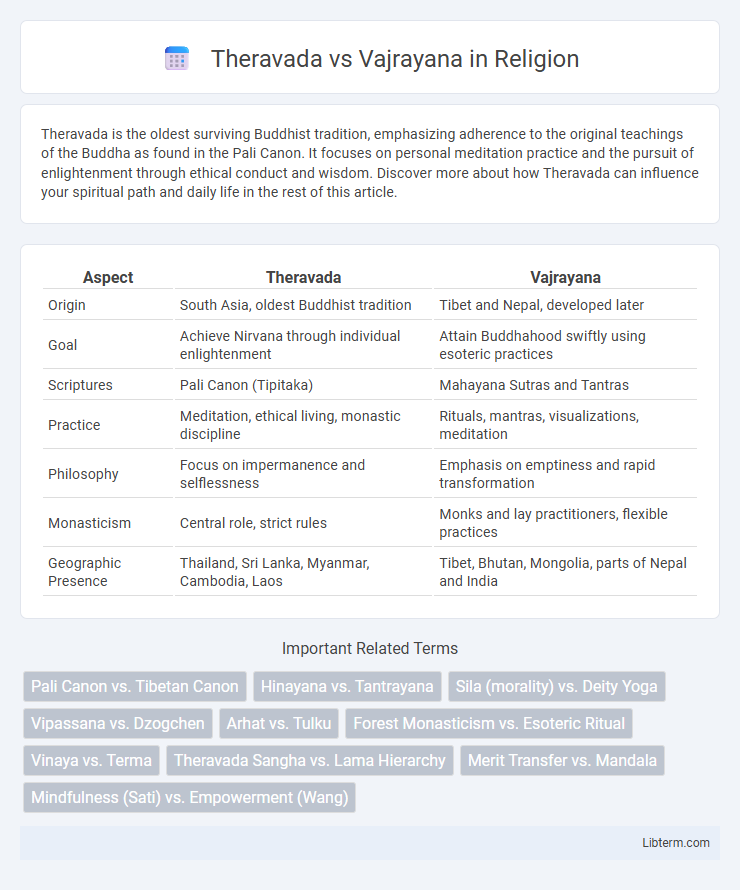Theravada is the oldest surviving Buddhist tradition, emphasizing adherence to the original teachings of the Buddha as found in the Pali Canon. It focuses on personal meditation practice and the pursuit of enlightenment through ethical conduct and wisdom. Discover more about how Theravada can influence your spiritual path and daily life in the rest of this article.
Table of Comparison
| Aspect | Theravada | Vajrayana |
|---|---|---|
| Origin | South Asia, oldest Buddhist tradition | Tibet and Nepal, developed later |
| Goal | Achieve Nirvana through individual enlightenment | Attain Buddhahood swiftly using esoteric practices |
| Scriptures | Pali Canon (Tipitaka) | Mahayana Sutras and Tantras |
| Practice | Meditation, ethical living, monastic discipline | Rituals, mantras, visualizations, meditation |
| Philosophy | Focus on impermanence and selflessness | Emphasis on emptiness and rapid transformation |
| Monasticism | Central role, strict rules | Monks and lay practitioners, flexible practices |
| Geographic Presence | Thailand, Sri Lanka, Myanmar, Cambodia, Laos | Tibet, Bhutan, Mongolia, parts of Nepal and India |
Introduction to Theravada and Vajrayana Buddhism
Theravada Buddhism, known as the "Doctrine of the Elders," emphasizes the original teachings of the Buddha with a focus on monastic discipline and meditation aimed at individual enlightenment, mainly practiced in Sri Lanka, Thailand, and Myanmar. Vajrayana Buddhism, often called the "Diamond Vehicle," incorporates tantric practices, rituals, and esoteric teachings designed to accelerate enlightenment, predominantly found in Tibet, Bhutan, and Mongolia. Both traditions share the core Buddhist principles but differ significantly in methods, rituals, and cultural expressions.
Historical Origins and Geographic Spread
Theravada Buddhism originated in the Indian subcontinent around the 3rd century BCE and is closely associated with the Pali Canon, emphasizing early Buddhist teachings. It primarily spread to Southeast Asian countries like Sri Lanka, Thailand, Myanmar, Laos, and Cambodia, where it remains the dominant tradition. Vajrayana Buddhism evolved later, around the 7th century CE, incorporating tantric practices and proliferated primarily in Tibet, Bhutan, Nepal, and Mongolia, blending Mahayana philosophy with esoteric rituals.
Core Philosophical Differences
Theravada emphasizes the original teachings of the Buddha, focusing on individual enlightenment through insight meditation (vipassana) and adherence to the Pali Canon, prioritizing the Four Noble Truths and the Eightfold Path. Vajrayana incorporates tantric practices, rituals, and esoteric symbolism, aiming for rapid enlightenment by transforming ordinary experiences into spiritual realization through deity visualization and mantra recitation. Theravada's philosophical framework centers on impermanence and non-self, while Vajrayana integrates Mahayana concepts of emptiness (shunyata) and compassionate bodhisattva ideals within its unique tantric methodology.
Key Practices and Rituals
Theravada Buddhism emphasizes Vipassana meditation, adherence to the Pali Canon, and monastic discipline as core practices, focusing on insight into impermanence and suffering. Vajrayana Buddhism incorporates Tantra, mantra recitation, mandalas, and deity visualization, blending esoteric rituals with meditation to accelerate enlightenment. Rituals in Vajrayana involve elaborate ceremonies and initiations (abhisheka), distinguishing it from the more austere Theravada traditions.
Role of Monastic Community
The Theravada tradition emphasizes the monastic community (Sangha) as the primary custodian and teacher of the Buddha's teachings, with monks playing a vital role in preserving and transmitting the Pali Canon. Vajrayana Buddhism incorporates a more esoteric approach where monastic practitioners, along with lay tantric practitioners, engage in advanced rituals and meditation practices to attain enlightenment. The Sangha in Vajrayana often includes both monastic and non-monastic practitioners, reflecting a more flexible and inclusive role in spiritual development.
Concept of Enlightenment
Theravada Buddhism emphasizes enlightenment (nirvana) as the liberation attained through individual effort, primarily by following the Noble Eightfold Path and deep meditation to eradicate desire and ignorance. Vajrayana Buddhism incorporates the concept of enlightenment as an accelerated path, utilizing esoteric rituals, mantras, and deity visualizations to transform ordinary perception and achieve Buddhahood within a single lifetime. Both traditions uphold enlightenment as the ultimate goal but differ in their methodologies and spiritual practices for realizing it.
Use of Sacred Texts and Scriptures
Theravada Buddhism primarily relies on the Pali Canon (Tipitaka), which is considered the most authoritative and earliest collection of the Buddha's teachings, emphasizing strict adherence to monastic rules and mindfulness practices. Vajrayana Buddhism incorporates the Mahayana Sutras along with esoteric texts known as Tantras, which contain ritual instructions and symbolical meanings used in advanced meditation and tantric practices. The use of sacred texts in Vajrayana is often more symbolic and ritualistic, aimed at achieving enlightenment swiftly through complex visualizations and mantra recitations.
Iconography and Symbolism
Theravada iconography emphasizes simplicity, often featuring images of the Buddha in meditative poses that highlight enlightenment and teachings, with symbolic elements like the lotus and the Bodhi tree representing purity and awakening. Vajrayana iconography is richly elaborate, incorporating intricate mandalas, wrathful deities, and tantric symbols such as the vajra (thunderbolt) and bell, which signify the union of wisdom and compassion. Symbolism in Theravada focuses on the historical Buddha and his path to liberation through ethical discipline, while Vajrayana symbolism integrates esoteric rituals and visualizations aimed at transforming ordinary experiences into spiritual insight.
Meditation Techniques Compared
Theravada meditation emphasizes Vipassana (insight) and Samatha (calm-abiding) techniques aimed at mindfulness and concentration through breath awareness and body scanning. Vajrayana meditation incorporates advanced tantric practices such as visualization, mantra recitation, and deity yoga to transform ordinary experiences into spiritual realization. Both traditions seek enlightenment but employ distinct approaches--Theravada focuses on gradual insight and mental purity, whereas Vajrayana uses ritualized, esoteric methods to accelerate awakening.
Modern Influence and Global Presence
Theravada Buddhism maintains a strong presence in Southeast Asia, influencing modern meditation practices worldwide through mindfulness and vipassana techniques popularized in Western wellness circles. Vajrayana Buddhism, prevalent in Tibet, Mongolia, and Bhutan, has gained global recognition through its rich ritualistic traditions and the international prominence of Tibetan spiritual leaders. Both traditions adapt to contemporary societies, with Theravada emphasizing simplicity and introspective meditation, while Vajrayana integrates elaborate symbolism appealing to diverse global audiences seeking spiritual depth.
Theravada Infographic

 libterm.com
libterm.com